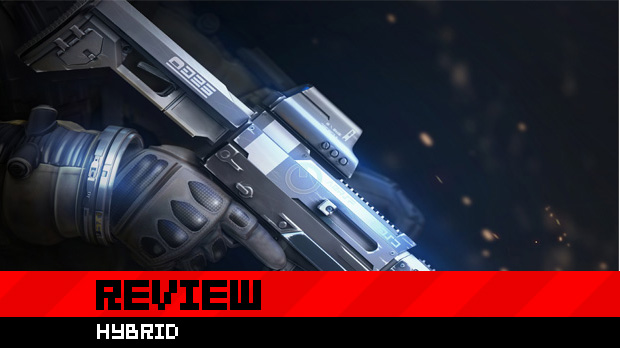Third-person shooters are a dime a dozen. From games like Gears of War to the recent Spec Ops: The Line, cover tends to play heavily into the combat, but you’d be hard pressed to find one that fully revolves around cover as not only the tactic but the main focus of gameplay. That is, until Hybrid came along.
Offering a unique spin on the third-person shooter genre with a persistent world map and online-only play, Hybrid is an unexpected surprise in the Summer of Arcade line-up.
That’s not to say it’s a perfect game, but it’s certainly a surprising one.

Hybrid (Xbox Live Arcade)
Developer: 5th Cell
Publisher: 5th Cell
Released: August 8, 2012
MSRP: 1200 Microsoft Points
When I say the cover system is the main focus of the gameplay, I mean that the only movement in the game is from cover to cover. That’s it. Basically, you point the camera at the cover, press the A button, and your character jet-packs on over to it. You can strafe and swoop, bob and weave while you fly, and walk along the cover or vault over it once you’re there, but make no mistake; this is the extent of your movement in Hybrid. You either blind shoot from cover, aim from cover, or shoot while moving from cover to cover.
Granted, cover can be on the ground, on the wall, or even on the ceiling, but that’s what you’re limited to. While this may sound … well — pretty terrible, honestly — it’s actually more fun than you’d imagine. There’s a certain urgency when flying around, as you try to make sure you’re not heading to cover that contains your foe directly behind it. Or maybe that’s exactly what you want. Either way, it’s definitely a style of gameplay I had to get used to in my first few matches. There’s a quick tutorial at the beginning, but bots do not compare to live players.
There’s a plot here, apparently concerning Dark Matter and its acquisition across the continents of Earth between two factions fighting for it, the Paladins (humans) and the Variants (aliens). Somehow, shooting the ever loving shit out of each other in three-on-three firefights determines who gets Nibbler’s poop.

The story is a thin shell used to explain why you’re killing each other, and serves as the framework for the world map. As battles wage on, each section of the map shows who’s taken what region. Each individual region within a continent is also labelled with a specialization. As you complete matches, you rank up your specialization, be it Assassin, Commander, etc. These specialization have tiered ranks (1-5) and during your loadout before matches, you can choose a specialization along with your weapon and an ability. The specializations you choose here do not have to be the one specific to the region you’re in, as they offer varying boosts to experience, health, weapon damage or cool-down rates. The tiered ranking determines how much of a percentage the given specialization helps. It sounds confusing, but once you’ve gotten acclimated to how the specializations affect gameplay, it helps you choose which regions to attack.
Once in battle, XP and kill streaks are the name of the game. You get rewards almost immediately in the form of drones. After one kill, you’re awarded with a Stalker, a little drone with a small rate of fire. Three kills gives you a heavier, larger Warship, and five kills lets you use the Preyot, a female android assassin who screams and flies at your foe with a one-hit kill shot from her sword. When and where to utilize each of these can be crucial in fights, as they can be stacked so you can have one of each running at once, but activating them causes a flash of light next to you, which can give away your position.
Matches are your standard fare, and while the majority of the time you’ll end up in a team deathmatch, there are several other gameplay types. For example, Artifact rewards the team who holds onto the item the longest, while Crazy Kings is kill of the hill with a moving “hill.” As you progress and level up, you will unlock more weapons, helmets, and abilities, but can optionally purchase credits with real money to buy these items ahead of time. Weapons are your standard-behaving light machines guns, shotguns, pistols, sniper rifles, etc., but with the limited movement, it all depends on if you’re better at blind firing or at close range around immediate corners.

Abilities are another matter altogether. Operating on a cool-down timer, these range from standard frag grenade and smoke bombs to grenades that can hack your enemies’ drones to attack them instead of you. There are also weapon enhancements that can poison or siphon enemy health, support powers that can detect foes behind cover or offer a health boost to your entire squad and more. Knowing when to use these, as well as seeing your fellow teammates’ loadouts can really help strategize during battle.
Strategy is key here, because when it comes down to the firefights themselves, things can be a little standard if you’re not going in prepared. Level design is minimum and with the focus purely on moving from cover to cover, all the maps tend to feel the same (with the exception of some levels offering cover on walls and ceilings). While they aren’t really anything special, it’s your loadouts and careful execution of your drone deployment that really make this a fun, almost arcade-style shooter.
It’s not a ground-breaking title, but it definitely offers a cool twist on the shooter genre. While I wasn’t completely sold on the cover-only gameplay, after a few matches, I found myself really enjoying the time I had put into the game. Hybrid is certainly not what I expected, but with the right mindset, players can get a different experience than most shooters provide nowadays.













Published: Aug 13, 2012 05:00 pm